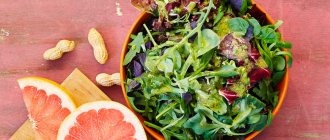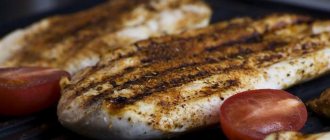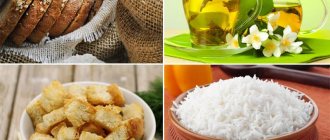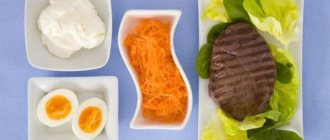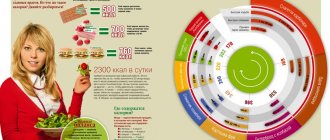When choosing a diet, a person focuses on the effectiveness of the method, personal preferences and the availability of food. Another possible motive is curiosity. The paleo diet has received positive reviews among professional athletes and those who care about their health, the menu of which is accessible to everyone and does not require much time for cooking. Such nutrition will get rid of extra pounds, help you feel light, and improve the health and condition of your hair, nails and skin. So how does the Paleo diet work and what is it? Let's find out!
The paleo diet is based on the principles of the supposed diet of a Stone Age inhabitant. In the menu of ancient man one cannot find milk and dairy products, grains, sugars and, in principle, food that undergoes technical processing and contains chemical additives.
The basis of nutrition is high-quality protein products (meat and poultry, fish and seafood, eggs) and fiber-rich fruits and vegetables, nuts and berries. To summarize, the diet uses those foods that the caveman obtained by hunting or gathering.
In this article we will cover:
- what are the principles of nutrition and what is the paleo diet in principle;
- athletes of which sport like the principles of nutrition in the image and likeness of ancient man;
- what the autoimmune protocol is and how it works;
- how to create a menu for the week from the allowed list of paleo foods.
What is the paleo diet
The full name is the Paleolithic diet or “diet of the ancients.” American nutritionists Lauren Corday and Oz Garcia suggested eating according to the principle of the ancestors of the Paleolithic era. Researchers have suggested that since that time there have been no changes in the human genetic code, so the best option for the body is to eat natural foods.
Prepared foods, semi-finished products, products with flavor enhancers and emulsifiers are harmful to health. The founders of the paleo diet suggest getting rid of such ingredients for a while in order to track changes in your body and cleanse it. The main goal of eating according to the principle of ancient man is to restore health, and those losing weight noted positive results in losing extra pounds by practicing a diet.
The Paleolithic nutrition menu is rich in vitamins, microelements and promotes:
- stabilization of hormonal levels;
- reduction of fat layer;
- reducing blood sugar and “bad” cholesterol;
- regulation of blood pressure;
- reducing stress and improving mood;
- prevention of atherosclerosis, hypertension and other disorders of the cardiovascular system.
General rules
The paleo diet gets its name from the phrase “paleo diet.”
You can also find other names for it - “diet of the ancients” or “diet of the Stone Age”. There is a reason why diet foods have such unusual names. Two American nutritionists, Lauren Cordain and Oz Garcia, have created a new diet based on how our Paleolithic ancestors ate. Later, Lauren's student Robb Wolfe released a book detailing the basics and principles of the natural paleo diet. It is believed that the human genetic code has not changed since ancient times, and the healthiest diet is based on natural products. Ready-made meals and semi-finished products enriched with flavor enhancers and emulsifiers have a negative impact on health. During the diet, it is recommended to give up everything that negatively affects the human body and adhere to a healthy diet. The Paleo diet's main goal is to restore health, but it can also be successfully used to lose excess weight. rich in microelements and vitamins , has a number of undeniable advantages:
- stabilization of hormonal levels ;
- stabilization of blood pressure ;
- getting rid of extra pounds;
- prevention of hypertension ;
- prevention of the development and progression of atherosclerosis ;
- decreased blood sugar levels;
- cholesterol reduction .
Advantages and Disadvantages of the Paleo Diet
The nutritionist community is divided into two camps:
- Some consider the paleo diet to be dangerous to health due to the risk of disruption of body functions with prolonged practice of the approach.
Opponents rely on studies that indicate a risk of developing cardiovascular disease due to excessive amounts of protein in the diet. At the same time, scientists categorically do not accept the exclusion of complex carbohydrates, which include cereals, arguing that this is due to a slowdown in metabolism, gastrointestinal disorders, disruption of the hormonal system and a decrease in vitality.
- Followers of ancient man's nutrition insist that high-quality protein products in combination with vegetables and fruits will strengthen the immune system, promote weight loss and make skin, hair and nails healthy.
Benefits of the Paleo Diet
There are three main beneficial aspects of paleo:
Speed of result
Replacing carbohydrate products with protein and large amounts of fiber is a set of changes in eating behavior that leads to rapid weight loss. Already in the 3rd week, changes in volume and reflection in the mirror are noticeable, so this approach is popular among those losing weight.
No feeling of hunger
On a Paleolithic diet, you will not have to go hungry due to stable blood sugar levels. Products on the approved list have a low glycemic index. This means that glucose enters the blood in small doses, insulin is stable, and appetite is under control.
Caloric content of the diet
The daily calorie intake is calculated individually, because the diet does not have a strict framework. It is enough to consume permitted foods, excluding forbidden foods. Compared to standard calorie-reducing diets, paleo nutrition practices keeping glucose levels low, which leads to the loss of subcutaneous fat.
Features and rules of the paleo diet
The developers of the paleo diet claim that with such a diet you can successfully lose weight. They rely on scientific data. In support of their statements, they argue that the diet that our ancestors followed before the advent of agriculture is the most natural and most suitable for humans.
The first mention of this diet dates back to 1975, when doctor Walter Vogtlin published a book called “The Stone Age Diet.” In this book, he said that the basis of human nutrition should be meat, as well as boiled vegetables and fruits. The author claims that man has not changed at the genetic level in 10,000 years and remains the same hunter-gatherer. And the current food industry is created in such a way that people consume large amounts of processed grains, processed animal fats, meat from animals raised on grains, sugar and salt. And in this the author sees the essence of human problems with digestion and excess weight.
But the paleo diet became most widespread thanks to the publication of a book of the same name by author Loren Cordain in 2002. The slogan of this book is: “Eat what nature intended...”, from which we can conclude that the author is talking about how our ancestors were healthy thanks to natural, minimally processed live foods and a natural lifestyle.
Important! Experts are divided on the paleo diet. There is no exact evidence of what exactly and how much our ancestors consumed and how it affected their health. It is believed that among Neanderthals, food of plant origin rather than animal predominated on the menu.
In addition to strict dietary restrictions, there are several more principles on which the paleo diet is based:
- Move as much as possible. Natural physical labor and running are encouraged as much as possible.
- Eat only when you feel hungry. In fact, a person needs a very small amount of food per day to ensure the vital functions of the body. Rebuilding your eating habits and starting to listen to your body are some of the basic principles of the diet.
- Products for the paleo diet should be chosen only those that could theoretically be present in the diet of Stone Age people. The rest should be excluded. Of course, we cannot know for sure whether cereals or some type of vegetables were present in the diet of our ancestors, but what was definitely not there was pasta and sweets.
There is still a lot of controversy about the essence, dangers and benefits of the paleotic diet. Supporters claim that with such a diet you can not only lose weight by getting rid of fat, but also solve many problems with the gastrointestinal tract, strengthen the immune system and improve the condition of hair and nails.
Opponents argue that the paleo diet is harmful by saying that excess meat and protein foods are bad for the heart and blood vessels, and the lack of certain types of healthy foods, including complex carbohydrates, leads to a slowdown in metabolism, disruptions in the hormonal system, problems with the intestines and general health. state of health.
The low-carbohydrate menu of the Paleolithic diet is perfect for people with lactose intolerance or those who cannot imagine their life without meat.
Crossfit and paleo
In CrossFit, women and men keep their bodies in shape by getting rid of subcutaneous fat in order to successfully complete training routines. Training with high duration and intensity in tandem with a paleo diet can get rid of excess weight in a short time.
Mechanism of operation: intensive training aimed at all muscle groups requires the body to recover immediately after the end of the session. During this period, muscle tissue has depleted glycogen reserves, which athletes usually replenish with fast carbohydrates.
Consuming protein immediately after training activates the process of ketosis (the breakdown of fat reserves for energy), so the combination of CrossFit and Paleolithic nutrition helps to lose excess weight.
Intense physical activity in CrossFit on a paleo diet can lead to fatigue. To prevent overtraining, it is recommended to include in the menu fruits rich in carbohydrates, starch, pectin - grapes, apples and pears, bananas, peaches. Sources of fats and amino acids are nuts, red fish, unrefined oil.
Reviews from elite athletes about the paleo diet
The Paleo diet and CrossFit are considered young phenomena, dating back to the 2000s. However, training results, strength indicators and feedback from athletes deserve special attention.
The pioneer in testing the Paleolithic diet was CrossFit founder Greg Glassman. Having experienced the effectiveness from personal experience, the athlete recommends following the principles of nutrition: eat meat, nuts and seeds, remove sugar and flour products in order to increase the effectiveness of training and not gain weight due to fat. Glassman states that the paleo diet is the most optimal for humans, and the abuse of carbohydrates leads to the development of diabetes.
Famous in professional women's CrossFit, Jackie Perez is also a proponent of the ancient man diet. Before multifunctional training, Jackie paid attention only to cardio and strength training in the gym, without monitoring her nutrition. For a long time, the body shape remained unchanged. But when the athlete came to the CrossFit gym, started working out with a trainer and maintaining a paleo diet, she didn’t have to wait long for results.
Sarah Ballantyne's Paleo Autoimmune Protocol Don't List:
All grains and some cereals (rye, barley, spelled, oats, buckwheat, millet, amaranth, quinoa, corn, sesame, yeast, tapioca, rice and buckwheat included). Legumes. All dairy products containing lactose, casein and their derivatives. Refined sugar and oil. Eggs. Nuts and seeds (including cocoa, coffee and seed spices). All nightshades (tomatoes, potatoes, eggplants, paprika, chili, goji berries and pepper spices). Alcohol. Nonsteroidal anti-inflammatory drugs (ibuprofen and aspirin). All sweeteners, including stevia. Emulsifiers and emulsifiers. Do not overuse: fructose, salt, dried fruits, foods rich in omega-6, black and green tea. Gradually you can introduce: yolks, edible pods, walnut oil, macadamia oil, ghee, whole coconut products - cream and milk (no more than a cup per day), flour, cereal.
Contraindications
Contraindications to the paleo diet are:
- disruption of the liver and kidneys;
- exacerbation of chronic diseases;
- problems with the functioning of the gastrointestinal tract;
- pregnancy, breastfeeding period.
- The approach is not recommended for adolescents and children.
Important Terms
If you feel weak and dizzy while on a diet, the reason for this is a deficiency of calories consumed. To provide the body with the necessary amount of energy, it is recommended to increase portions of meat, poultry or fish. It is useful to eat nuts between meals.
Bodymaster.ru recommends Fitness Trainers:
Health problems are caused by foods containing gluten, peanuts, and soy. The golden mean between two opposite groups is tomatoes (the substances that make up the vegetable stimulate the immune system and are used in pharmacology in the development of vaccines).
The autoimmune protocol differs from the paleo diet in the list of permitted and prohibited foods. The difference depends on the complexity of the disease - the better the health, the more you can afford, and vice versa. It can be said that the technique is stricter in its approach to food, leaving the best for each person.
The main goal is to saturate the body with essential nutrients (BJU) and eliminate unwanted foods that provoke an autoimmune response. In the protocol, the diet is freed from foods that interfere with health. Having completed the autoimmune protocol, everything prohibited (especially nutritional components) returns to the menu, despite the potentially harmful properties.
The Paleolithic diet has been questioned due to its novelty and popularity, but numerous studies support positive health effects. Among the advantages:
- weight loss;
- diabetes prevention;
- therapeutic effects on autoimmune diseases.
A study was conducted where 15 people with inflammatory bowel disease smoothly switched to an autoimmune protocol over 6 weeks, and then spent 5 weeks on a diet. Improvements were monitored after week 6 in 11 out of 15 subjects in the form of remission over the course of 5 weeks of the experiment.
How the Autoimmune Protocol Works
The work of the Paleo Autoimmune Protocol extends to 4 areas susceptible to autoimmune diseases. Thanks to research, recommendations have been formed:
Nutrients
Full functioning of the immune system is possible if it is saturated with vitamins, minerals, antioxidants, amino acids and fatty acids. The cause of the development of autoimmune pathologies is an imbalance and deficiency of nutrients. If you focus on consuming foods rich in microelements, imbalances and deficiencies in the immune, excretory, hormonal and nervous systems are reduced. Standard indicators will help restore damaged tissue.
Gut Health
Dysbacteriosis is a trigger for the development of autoimmune pathology. Paleo foods can maintain the balance of beneficial intestinal microorganisms. Avoid foods that can damage or disrupt the mucous membrane.
Hormonal regulation
Food directly affects hormones, which are also related to immunity. If there is a lot of sugar in the diet, it causes hormones to work in a frantic rhythm, stimulating the immune system. The Autoimmune Protocol diet will restore balance. In addition, it is important to get enough sleep, spend more time outdoors and lead an active lifestyle.
Immune regulation
Regulation is carried out by introducing diversity and a sufficient number of microorganisms in the intestines.
Quitting the diet
Grains are gradually introduced into the diet in portions. It is recommended to alternate oatmeal, buckwheat, and brown rice. Butter remains restricted and is introduced in the second week of leaving the diet. In the second week, you can add unrefined vegetable oil.
Recommendations
When following the autoimmune protocol, it is recommended:
- time limit;
- Objective assessment;
- individual preparation of the AIP diet menu.
Severe short-term dietary restriction for lifelong health problems is advisable. In AIP there is no serious nutritional deficiency; Following this program, the body relaxes, the intestines are restored, and begin to function better. There is no point in restricting your diet in the long term. More restrictive diets carry the risk of limited nutrient intake and stress. Therefore, after a few weeks, you should evaluate the result of the dietary change and supplement it with other products in accordance with your condition.
The problem with most diets is the subjectivity of evaluation, since success may be due to the placebo effect. Therefore, it is better to assess the condition with a doctor; he will confirm the functionality of diet therapy from an independent point of view, in accordance with objective parameters.
Recommendations and opinions on creating a diet for the AIP diet (what you can eat, what you can’t) that are available on the Internet often do not agree. This does not mean that some of them are wrong. This variability is due to the different needs of each person. Therefore, it is recommended to closely monitor the body's reactions during diet therapy (physical response, mental well-being). Based on the findings, you can customize your own autoimmune protocol.
Comments from nutritionists
Nutritionists around the world paid attention to the new product. Doctors agree that a natural diet will help reduce the percentage of subcutaneous fat. Proper nutrition – disease prevention. The list of permitted products is unique and suitable for everyone. The exception included people with pathologies of the stomach and kidneys.
Experts recommend monitoring the processes occurring in the body at the time of change in eating behavior to the Paleolithic principle of nutrition and adjusting the menu, focusing on individual characteristics.
Authorized Products
The menu includes ingredients that allow you to prepare a large number of dishes. No monotony planned! But despite the variety of components, the modern lifestyle requires more.
The main principles of compiling the main menu
The body's need for nutrients can be met by following the principles:
- observe the drinking regime, give preference to clean still water;
- eat more berries and fruits - antioxidants will tone the body, improve mood and stabilize the immune system;
- seeds, nuts, fruits and vegetables are the main ingredients of the diet that normalize the functioning of the cardiovascular system and support the myocardium;
- choose organic products;
- sources of vegetable protein – almonds and hazelnuts;
- sweets will replace honey, coconut sugar;
- source of animal protein – lean varieties of meat, poultry, fish.
Table of permitted products
The diet of “ancient man” includes:
| Product group | Products |
| Lean meat, poultry | Veal, beef, pork, chicken, turkey (preferably buy organic products) |
| Fish and seafood | Any sea fish, not fatty river fish, mussels, shrimp, squid, crabs, etc. |
| Fruits | The main source of carbohydrates. There are no restrictions on the assortment, but bananas and grapes are consumed in limited quantities |
| Vegetables and greens | Any, except potatoes (replaced with sweet potatoes), corn |
| Mushrooms | No limits |
| Nuts | No limits |
| Eggs | Chicken, quail |
| Vegetable oil | Unrefined |
The benefits and harms of diet
The “Stone Age” diet consists of foods rich in animal protein, vitamins A, C, E, fiber, and Omega-3 fatty acids.
This means that following a paleo diet can lead to the following beneficial results:
- improvement of the external condition of skin and hair;
- reducing the level of “bad” cholesterol (only if you do not eat fatty meats);
- normalization of intestinal microflora and digestion;
- strengthening the immune system;
- decreased blood sugar levels;
- cancer prevention.
Weight loss is achieved due to a low calorie diet. On the Paleolithic diet, judging by the reviews, people manage to lose an average of 2–6 kg per month.
Most scientists are skeptical about the “paleo” diet and consider it divorced from reality. The main complaints are as follows:
No one knows the exact diet of ancient people
New York University professor Marion Nestle speaks about this, in particular. Scientists have suggested that our ancestors in the Paleolithic era could have consumed raw cereals.
The human digestive system has undergone significant changes over several thousand years.
Joan Blake, a spokeswoman for the American Dietetic Association, says the Paleolithic diet's genotype argument is pseudoscientific. Over 10 thousand years, the human digestive system has changed greatly and adapted to new foods.
Interesting fact. Even 8 thousand years ago, not a single inhabitant of Europe could tolerate milk. Now only every 4th person has lactose deficiency.
The long-term benefits of the Paleolithic diet have not been proven.
There are no serious scientific studies conducted on large control groups of people that would confirm the health benefits of the Paleo diet. The effectiveness of this power system is based on assumptions.
Important! The average life expectancy of a person in the Paleolithic era was 25 years. Therefore, it is difficult to definitively determine whether the meat and vegetable diet protected homosapiens from chronic diseases.
Imbalanced diet
The Paleolithic diet and cottage cheese (cheese, other milk) are incompatible concepts. This means that a person does not receive enough calcium, which, in conditions of low physical activity, can lead to the development of osteoporosis.
Since the ban applies to grains and legumes, the body experiences a deficiency of B vitamins, magnesium and iron. And this is fraught with problems with the nervous system and brain.
Attention! If you follow the Paleolithic diet, you may experience bad mood, chronic fatigue, and even depression.
A lack of sodium (due to a ban on salt) can cause an imbalance in the water-salt balance in the body. Symptoms include dry skin, high blood pressure, muscle weakness and kidney problems. A complete lack of salt in the diet in hot weather is a direct path to dehydration.
Table of prohibited products
Semi-finished products, canned food, baked goods, soda, seasonings, and sugar are removed from the diet.
| Product group | Products |
| Legumes | Chickpeas, lentils, beans, peas, peanuts (block mineral absorption) |
| Cereals, pasta | Oatmeal, buckwheat, rice, millet, pasta |
| Bread, bakery products | Bagels, bagels, pies, donuts |
| Dairy and fermented milk products | Milk, cheese, cottage cheese, kefir, cream, fermented baked milk, sour cream (an adult does not have enzymes capable of digesting lactose) |
| Sugar | Any industrial desserts, sweets, chocolate, cakes |
| Meat products | Sausages, sausages, dumplings, lard |
Prohibited foods on the paleo diet
Of course, it is difficult to imagine yourself in the place of people who lived several thousand years ago, when the world was completely different. There are some foods we can eliminate from the Paleo diet with absolute certainty. Others are the subject of constant debate or are considered “permissible”, but with reservations and restrictions.
The Paleolithic era lasted a very, very long time and included so many changes that it is simply impossible to take into account everything. Therefore, the boundaries of what is permissible remain at the discretion of everyone.
- Artificial additives and preservatives. Food additives that should be avoided not only by paleo dieters, but by anyone who cares about their health: monosodium glutamate (MSG), nitrates, potassium bromate, saccharin, artificial colors, artificial sweeteners and GMOs.
- Fast food. If you are watching your figure and want to stay healthy, then fast food options are not suitable for you. Refined oils, trans fats, sugar, breading and artificial sauce ingredients have nothing to do with healthy nutrition. The relatively small number of calories that are sometimes listed on the package does not make any difference.
- Legumes and grains. The Paleo diet excludes all types of grain legumes. Wheat, oats, rye, beans, soybeans, buckwheat, rice and other crops are prohibited. Thus, you give up bread, porridge, buns and many other products that were on your table.
- Milk products. All dairy products on the paleo diet are on the prohibited list.
By the way, many people are lactose intolerant, and humans are the only creature that drinks milk after infancy.
To achieve quick results and lose weight, you need to limit the amount of carbohydrates as much as possible (the norm is 60 g daily).
Ancient people could not have had the way or ability to drink milk or produce dairy and fermented milk products such as kefir, yogurt and cheese. Therefore, if you decide to follow a paleo diet, you should avoid burrata, parmesan and sour milk.
- Potato. Potatoes are so popular that it seems impossible to exclude them. The vegetable grows in the ground, and it might seem natural that a paleo person would randomly find some wild potatoes. But as it turns out, growing potatoes requires a lot of effort. Therefore, the need for potatoes only increased when people stopped hunting and gathering, and began to stay in one place longer, farming and raising livestock.
- Alcohol. There is a theory that ancient man could have consumed overripe and slightly fermented fruits and vegetables. However, this is a very bold theory. Alcohol is excluded on the paleo diet.
Therefore, you will have to completely forget about milk, canned food, sweet buns, smoked meats, and pickles.
This is by no means an exhaustive list of foods prohibited on the paleo diet. However, this list will help give you a general idea of the paleo diet.
Read about the NO-CARBOHYDRATE DIET for weight loss HERE
Menu: meal plan
To summarize: the principle of nutrition of ancient man includes an extensive list of protein components, fruits and vegetables, and nuts. Sugar, flour and processed products are excluded. The menu for a week on a paleo diet is formed depending on your favorite ingredients.
The diet is based on a number of rules:
- after waking up and between meals, drink non-carbonated clean water in unlimited quantities. Be sure to follow the drinking regime during training;
- heat treatment of vegetables is short in order to preserve vitamins;
- if necessary, a vitamin-mineral complex is added;
- daily workouts allow you to increase the amount of carbohydrates consumed due to fruits and berries;
- A gentle paleo diet involves the inclusion of milk and fermented milk products in the diet.
Paleo diet: menu for the week
Below is a possible paleo diet for the week. Suitable for athletes and those losing weight. Meals are allowed to be swapped and adjusted to personal preferences.
| MONDAY | |
| Breakfast | Three-egg omelette/hard-boiled eggs + steamed vegetables |
| Snack | Apple or banana |
| Dinner | 100-200 g white fish or chicken fillet + vegetable salad |
| Snack | A handful (100 g) of berries/30 g of any nuts |
| Dinner | Vegetable salad sprinkled with crushed nuts, dressed with olive oil or lemon juice/vegetable stew of zucchini, bell peppers, onions and carrots + portion (400-500 g) of steamed chicken |
| TUESDAY | |
| Breakfast | Two-egg omelette/hard-boiled eggs + fruit salad |
| Snack | Banana or pear + a handful of fresh berries |
| Dinner | 200 g chicken fillet/200 g beef + side dish of stewed or steamed vegetables |
| Snack | A serving of fruit salad (banana, mango, melon), sprinkled with any nuts and seasoned with lemon juice |
| Dinner | Chicken breast (200-300 g), cooked in any way + 150-200 g boiled asparagus/green beans with olive oil |
| WEDNESDAY | |
| Breakfast | Three-egg omelette with herbs + a serving of fruit salad |
| Snack | Peach + a handful of fresh berries |
| Dinner | 150 g of seafood prepared in any way + salad of Chinese cabbage, cucumbers and herbs, dressed with olive oil |
| Snack | A handful of nuts (no more than 30 g) + apple |
| Dinner | 200 g steamed red fish + stewed cauliflower |
| THURSDAY | |
| Breakfast | Two eggs + fresh berries |
| Snack | A serving of fruit salad with apples and nuts |
| Dinner | 150 g steamed white fish + fresh vegetable salad (chinese cabbage, cucumbers, onions, bell peppers) |
| Snack | Banana or pear |
| Dinner | 200-300 g chicken breast fillet with mushrooms and herbs + boiled egg |
| FRIDAY | |
| Breakfast | Three-egg omelette with herbs + a serving of fruit salad |
| Snack | Apple or a handful of grapes (100 g) |
| Dinner | 200 g beef + 150 g baked sweet potato + fresh vegetable salad |
| Snack | A handful of nuts (up to 30 g) + banana |
| Dinner | 200 g boiled fish + stewed vegetables |
| SATURDAY | |
| Breakfast | Two eggs + fruit salad |
| Snack | Banana + a handful of nuts |
| Dinner | 200 g red fish, cooked in the oven with lemon + grilled vegetables |
| Snack | A serving of fruit salad + a handful of fresh berries |
| Dinner | 200 g steamed turkey fillet + vegetable stew of cauliflower, zucchini, eggplant and onion |
| SUNDAY | |
| Breakfast | Omelette of two eggs with herbs + steamed vegetables (zucchini, cauliflower) |
| Snack | A small handful of nuts (up to 30 g) + apple |
| Dinner | 150 g beef, cooked in the oven with mushrooms + fresh vegetable salad |
| Snack | One banana + a handful of fresh berries |
| Dinner | 200 g stewed white fish with onions and herbs + a portion of steamed vegetables |


